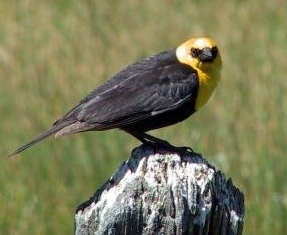|
Medium-sized
blackbird with black body, bright yellow hood and breast, and distinct
white wing patches. Bill, legs and feet are black. Forages in low vegetation
and on the ground. Feeds on insects, larvae, snails, seeds, and grains.
Strong direct flight on rapid wing beats.

|
YELLOW-HEADED
BLACKBIRD
Xanthocephalus xanthocephalus
PASSERIFORMES
Blackbirds and Orioles (Icteridae)
Range
and Habitat
Breeds from central British Columbia, northern Alberta, and Wisconsin
south to southern California, northern New Mexico, and Illinois. Spends
winters in southern U.S. and northern Mexico. Nests in freshwater marshes;
during migration and winter prefers open, cultivated lands, fields,
and pastures.
Depending
on the quality of his territory, a male Yellow-headed Blackbird may
be able to acquire up to six mates.
Males who acquire new territory do not destroy broods sired by the previous
territorial male.
They have one of the most unique bird calls. It has been described as
a strange mixture of honking,
gurgling and strangling noises.
SOUND: "croak"
In winter, single-species flocks may form, sometimes
consisting of all males or all females. Large foraging flocks move in
a rolling fashion, birds from the back of the flock
fly over the rest to the front.
A group of blackbirds has many collective nouns, including a "cloud",
"cluster", and "merl" of blackbirds.
The Yellow-headed Blackbird has an enormous range reaching up to generally
4.7 million kilometers. This bird can be found in Canada, the United
States and Mexico with vagrant colonies in such areas as Bahamas, Barbados,
Costa Rica, Cuba, Greenland, Iceland, Panama, Saint Pierre and Miquelon.
Its preferred habitat includes inland wetlands such as bogs, marshes,
swamps and fens and also arable and pasturelands as well. The global
population of this bird is estimated to be around 23 million individuals.
It is not believed that the population trends for this species will
soon approach the minimum levels that could suggest a potential decline
in population.

|